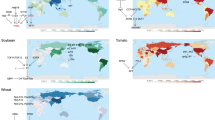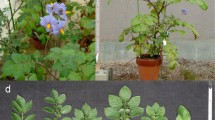Abstract
Observations made over the last fifteen to twenty years have discovered no primitive forms of G.barbadense L. orG. hirsutum L. (other than G.hirsutum racelatifolium Hutchinson) which are capable of flowering during the long summer days of temperate latitudes. Annual Upland cottons, grown in the southern United States since the mid-eighteenth century, were probably derived from perennial day-neutral forms of Mexican racelatifolium, though not necessarily by direct introduction from Mexico into the United States.
The origin of Sea Island cottons (day-neutral forms of G.barbadense), which were formerly grown on the southeastern seaboard of the United States since the mid-eighteenth century, remains obscure. No primitive forms of this species, capable of flowering during the long summer days of temperate latitudes, have been found.
An experiment is reported in which it has been possible to synthesize a day-neutral form of G.barbadense through introgression between primitive short-day sensitive forms of G.barbadense and G.hirsutum, both native to the Caribbean region. It is suggested that the ancestors of Sea Island cottons may have originated naturally by a similar mechanism involving the same species.
Similar content being viewed by others
Literature Cited
Mauney, J.R. and L. L. Phillips. 1963. Influence of daylength and night temperature on flowering in Gossypium. Bot. Gaz.124: 278–283.
Kohel, R.J. and T. R. Richmond. 1962. The genetics of flowering response in cotton. IV. Genetics47: 1535–1542.
The regional collection of cotton species, interspecific hybrids, races ofGossypium hirsutum and genetically marked stocks. 1956. Regional Research Project S-l, College Station, Texas. (Unpublished M.S.).
Raynal, G. T. F. 1774. Histoire philosophique et politique des établissements et du commerce des Européens dans les deux Indes.
Rohr, J. P. B. von. 1791. Anmerkungen über den cattunbau zum nuzen der dänischen westindischen colonien. J. F. Hammerich. Altona und Leipzig.
Lasteyrie, C.P. de. 1808. Du cotonnier et de sa culture. Bertrand, Paris. Pp. 446.
Amaral, L. 1958. Historia geral da agricultura brasiliera. Vol. 2. Compania Editora Nacional. São Paulo. (2nd edition).
Bittencourt, J. de S. 1798. Memoria sobre a plantacão dos algodoes. Pp. 257–272.In O auxiliador da industria nacional 1841. Impresão regia. Rio de Janeiro.
Gutierrez, M., J. Vrdolijak, A. A. Ricciardi, I. N. Tiranti, R. Carnevali, A. C. Galván, and M. J. Arturi. 1964. Variación geo gráfica deGossypium barbadense en el extremo austral de su dispersión Americana. Instituto Nacional de Tecnologia Agropecuaria (Argentina) Bol. No. 31. 102 pp.
Tussac, Fr. R. de. 1818. Flore des Antilles, ou histoire générale botanique, rurale, et économique, des végétaux indigènes des Antilles. Paris, chez l’auteur. (Libr. Congr. QK 225.T9).
Tozzer, A.M. 1941. Landa’s Relacion de las cosas de Yucatan. A Translation. Peabody Museum of American Archaeology and Ethnology, Harvard University Vol. 18.
Cook, O. F. and C. B. Doyle. 1927. Acala cotton, a superior Upland variety from southern Mexico. U.S.D.A. Circ. 2, Pp. 30.
Moore, J.H. 1956. Cotton breeding in the Old South. Agricultural History30: 95–104.
Bossu, J.B. 1771. Travels through Louisiana. Vol. 1: 377–379. T. Davis, London.
DeBow, J.D.B. 1846. The cotton plant. Commercial Review1: 245–320.
Pratz, L.P.du. 1774. The history of Louisiana, or of the western parts of Virginia and Carolina. T. Becket, London.
Stephens, S.G. and L. L. Phillips. 1972. The history and geographical distribution of a polymorphic system in New World cottons. Biotropica4: 49–60.
—. 1974. The use of two polymorphic systems, nectary fringe hairs and corky alleles, as indicators of phylogenetic relationships in New World cottons. Biotropica.6: 194–201.
Hutchinson, J.B. and H. L. Manning. 1945. The Sea Island cottons. Emp. Jour. Expt. Agric.13: 80–92.
Watt, G. 1907. The wild and cultivated cotton plants of the world. Longman’s, Green & Co., London. Pp. 406.
Owen, E.R.J. 1969. Cotton and the Egyptian economy. 1820–1914. Clarendon Press, Oxford. Pp. 416.
Lewis, C.F. and T. R. Richmond. 1957. The genetics of flowering response in cotton I. Fruiting behavior ofGossypium hirsutum var.marie-galante in a cross with a variety of cultivated American Upland cotton. Genetics42: 499–509.
— and —. 1960. The genetics of flowering response in cotton II. Inheritance of flowering response in aGossypium barbadense cross. Genetics45: 79–85.
Waddle, B.M., C. F. Lewis, and T. R. Richmond. 1961. The genetics of flowering response in cotton III. Fruiting behavior ofGossypium hirsutum racelatifolium in a cross with a variety of cultivated American Upland cotton. Genetics46: 427–437.
Stephens, S.G. 1967. Evolution under domestication of the New World cottons. Ciencia e cultura.19: 118–134.
Boulanger, J. and D. Pinheiro. 1971. Evolution de la production cotonnière au nordest du Bresil. Coton et Fibres Tropicales26: 319–353.
Stephens, S.G. 1974. Geographic and taxonomic distribution of anthocyanin genes in New World cottons. Jour. Genet.61: 128–141.
The American Ephemeris and Nautical Almanac. 1960. U.S. Govt. Printing Office, Washington, D.C.
The regional collection ofGossypium germplasm. A.R.S./U.S.D.A. Publ. ARS-H-2 August, 1974.
Author information
Authors and Affiliations
Rights and permissions
About this article
Cite this article
Stephens, S.G. Some observations on photoperiodism and the development of annual forms of domesticated cottons. Econ Bot 30, 409–418 (1976). https://doi.org/10.1007/BF02904663
Received:
Accepted:
Issue Date:
DOI: https://doi.org/10.1007/BF02904663




